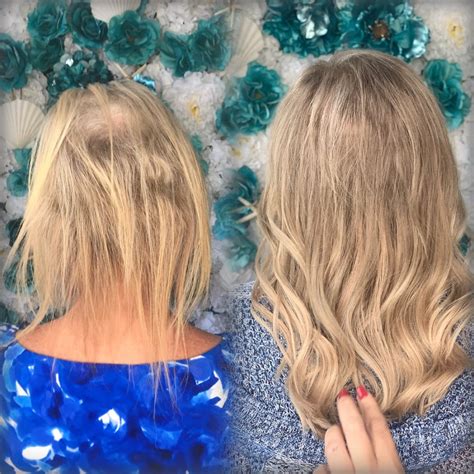Are you struggling with thin hair on top that makes you feel self-conscious? Hair extensions can be a game-changer, adding instant volume, length, and confidence to your locks. This guide will take you through the journey of hair extensions for thin hair on top, from the transformative before-and-after photos to expert tips and tricks.

Before: Understanding Thin Hair on Top
Thin hair on top, also known as alopecia areata, is a common condition affecting over 6.8 million people in the United States annually. This condition causes hair loss in circular or oval patches, leading to noticeable thinning on the scalp. The exact cause of alopecia areata is unknown, but it is believed to be related to autoimmune disorders, stress, and hormonal changes.
After: The Power of Hair Extensions
Hair extensions offer a non-surgical solution to combat thin hair on top. They are strands of artificial or human hair that are attached to your natural hair to add volume and length. There are various types of hair extensions available, including:
- Clip-ins: Temporary extensions that can be easily attached and removed.
- Tape-ins: Semi-permanent extensions that are attached using a medical-grade adhesive.
- Fusion: Permanent extensions that are bonded to your hair using heat or keratin glue.
Choosing the Right Hair Extensions
Selecting the ideal hair extensions for thin hair on top requires careful consideration. Here are some factors to keep in mind:
- Hair type: Choose extensions that match your natural hair texture for a seamless blend.
- Length: Consider the length you desire, bearing in mind that longer extensions may require more maintenance.
- Color: Opt for extensions that complement your natural hair color or add subtle highlights for a dimensional effect.
- Style: Explore extensions that can enhance your desired hairstyle, such as volume-boosting clip-ins or flowy tape-ins for added length.
Application: A Step-by-Step Guide
The application process for hair extensions varies depending on the type chosen. Here’s a general step-by-step guide:
1. Consultation: Consult a professional hairstylist to determine the best hair extension method and style for your needs.
2. Preparation: Wash and dry your hair without using any styling products.
3. Attachment: Your stylist will attach the extensions to your hair using the chosen method.
4. Blending: Your stylist will cut and blend the extensions with your natural hair for a seamless transition.
5. Styling: Style your hair as desired to complete the transformation.
Maintenance: Keeping Your Extensions Looking Flawless
To ensure your hair extensions last and look their best, follow these maintenance tips:
- Brush regularly: Use a wide-toothed comb or extension brush to gently detangle your extensions.
- Wash carefully: Use sulfate-free shampoos and conditioners to prevent damage.
- Avoid heat styling: Limit the use of heat tools, as they can weaken the bonds holding the extensions in place.
- Sleep with care: Avoid sleeping with wet extensions or tying your hair too tightly, as this can cause breakage.
- Visit your stylist regularly: Schedule maintenance appointments to have your extensions checked and adjusted as needed.
Common Mistakes to Avoid
To ensure a successful hair extension experience, avoid these common pitfalls:
- Selecting poor-quality extensions: Cheap extensions can tangle, shed excessively, and damage your natural hair.
- Overdoing it: Adding too much volume or length can weigh your hair down and make it look unnatural.
- Using the wrong application method: Choosing an inappropriate method for your hair type can result in damage or discomfort.
- Neglecting maintenance: Not following proper maintenance practices can shorten the lifespan of your extensions and compromise their appearance.
- Sleeping with extensions wet: Wet extensions can become knotted and damaged, leading to breakage.
Hair Extensions for Every Need
Hair extensions are not only suitable for thin hair on top. They can also cater to various hair concerns and styling preferences:
- Volume enhancement: Add fullness to fine or thinning hair for a more voluminous and youthful appearance.
- Lengthening: Transform short hair into long, flowing locks or add extensions to achieve a specific length for a glamorous makeover.
- Color transformation: Experiment with different colors and highlights to create a bold new look or subtle enhancements to your natural hair.
- Style versatility: Enhance updos, braids, and other hairstyles with added length and volume, allowing you to explore various styling options.
Frequently Asked Questions
1. How long do hair extensions last?
– The lifespan of hair extensions can vary from a few weeks (for clip-ins) to several months (for fusion and tape-ins), depending on the type and maintenance practices.
2. Will hair extensions damage my natural hair?
– When applied and maintained properly, hair extensions should not cause damage to your natural hair. However, it’s important to choose the right application method for your hair type and avoid overusing extensions.
3. Can I style my hair with hair extensions?
– Yes, you can style your hair with hair extensions. However, it’s recommended to use heat tools sparingly and opt for low-heat settings to prevent damage to the extensions and your natural hair.
4. How often should I wash my hair with extensions?
– The frequency of washing your hair with extensions depends on your lifestyle and hair type. Generally, aim to wash your hair every 2-3 days to maintain its cleanliness and prevent tangles.
5. Can I swim with hair extensions?
– While it’s possible to swim with hair extensions, it’s advisable to take precautions to protect them from chlorine and saltwater. Rinse your extensions thoroughly with fresh water after swimming and apply a leave-in conditioner to keep them hydrated.
6. Can I color my hair with extensions?
– Yes, you can color your hair with hair extensions. However, it’s recommended to consult a professional colorist who specializes in working with hair extensions to ensure the color process doesn’t damage the extensions or your natural hair.
7. How can I care for my hair extensions at home?
– Follow the maintenance tips outlined in this article, including brushing regularly, washing carefully, avoiding heat styling, sleeping with care, and visiting your stylist regularly.
8. What should I do if my hair extensions fall out?
– If you experience hair extension fallout, don’t panic. This is normal and can occur due to various factors. Check if your extensions are properly attached and consult your stylist to have them reattached securely.
Conclusion
Hair extensions offer a transformative solution for those struggling with thin hair on top. By carefully selecting the right type and following proper application and maintenance practices, you can enjoy the benefits of added volume, length, and confidence. Remember to prioritize hair health and consult a professional stylist to ensure a successful and satisfying
